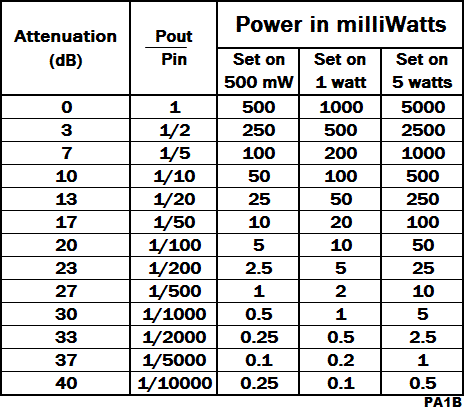The use of attenuators

A simple way to reduce the power of your QRP set to milliwatt level, without modifying the set, is the use of attenuators..
Homebrew 50 ohm attenuators are easy to build and can be placed between the set and the antenna or the tuner.
I developed very accurate 50 ohm Power Attenuators, which are built with resistors from the E12-series.
The antenna is connected to the transmatch (tuner). I match the antenna with the transmatch, with the attenuator set to 0 dB.
After adjusting the SWR, the input of the transmatch is 50 ohms, so the output of the attenuator “sees” 50 ohms and is properly terminated.
Disclaimer. When you use the attenuator, you can NOT use the auto tuner in the transceiver.
Lowest possible power
When I use the lowest possible power, I always use search and pounce. This means that I only answer to a CQ of other stations. I rapidly switch to the wanted (low) power, before I answer a CQ.
Only when I am certain that my signal is not heard, I will increase my power. When I have to increase my power, I usually make a step of 3 dB or 4 dB.
The S-meter is very important, when I use the lowest possible power. When a received signal is S9 + 10 dB, instead of 599, I reduce my power with 10 dB.

Lowest possible power
When I use an attenuator, I transmit, but also listen through the attenuator.
Please notice that with excellent propagation, the signal will be S9 +10 dB, so the signal behind the 10 dB attenuator will still be S9.
Experience in CW contest QSO’s
A contest station will work any station that they hear. They will answer to your response, as long as they can hear you.
I noticed in many CW QSO’s, that when my signal was heard, but my call was not copied, even after repeating 10 times, I only had to double my power, for my call to be copied immediately correct.
So in low power QSO’s in CW, a step of 3 dB or 4 dB is the optimal step to increase the power. The step of 10 dB is too large and 1 dB is too small.
Tips:
- For CW QSO’s with the lowest possible power, use steps of 3 dB or 4 dB. A step of 3 or 4 dB is the optimal step to increase power when your signal is not heard
- For WSPR, just use a 10 dB or/and a 20 dB attenuator, to reduce your power with 10 dB, 20 dB or 30 dB.
When you reduce your power with a step of 3 dB with WSPR, you will not notice any difference at all. - Reduce the power of your WSPR signal, by reducing the audio signal. Be sure that the power of your WSPR signal, is lower than the Nominal power of your attenuator.
FT-817 with attenuators

To go below 500 mW, which is the lowest power of my FT-817, I built an attenuator with a section of 10 dB and a section of 20 dB.
The power of the FT-817 is adjustable in a menu, so adding attenuators of 10 dB and 20 dB gives the possibility to operate with a few milliwatts.
To adjust the power that goes to the antenna, I use the FT-817 in combination with the attenuators.
With an attenuator of 10 dB and 20 dB, I can calculate the power that goes to the antenna instantly. An attenuator of 10 dB will divide the power by 10. This is merely moving the decimal point one place to the left.
An attenuator of 20 dB will divide the power by 100. This is moving the decimal point two places to the left.
When I use an attenuator, I transmit, but also listen through the attenuator.
Please notice that with excellent propagation, the signal will be S9+10 dB, so the signal behind the 10 dB attenuator will still be S9. Hi.
Read the interesting Article, that I wrote for SPRAT 152
Attenuator of 10 dB and 20 dB

Attenuator 10 dB and 20 dB – Nominal Input Power 1.1 W with resistors of 1 W and *250 mW
When the FT-817 is set to 500 mW and the attenuator is set to 10 dB, the attenuator will reduce the power to 1/10th, so the power will be 50 mW.
The FT-817’s QRP sequence
The power of the FT-817 can be adjusted in one of the menu’s. I always chose for this menu, to be accessible at any moment. The power is reduced with every push of the button.
The sequence is: 5 W, 2.5 W, 1 W, 500 mW and then 5 W again. However when I use the power adjustment, it is to increase the power, because my power is not enough to be heard.
To increase the power the button A must be pressed 3 times to increase the power with one step. For example from 500 mW to 1 W.

The table is run through, from the bottom to the top.
Very fast in QSO’s
The sections of this attenuator are 3 dB, 7 dB, 10 dB and 20 dB. So the this attenuator will be switched in steps of 3 dB or 4 dB.
In stead of switching the power of the set, the attenuator will be switched. Because of the sections of 3 dB, 7 dB and 10 dB, the switching is instantly, thus very fast.
If your set has the possibility to chose the power, you can chose the lowest power, for example 500 milliwatt.
Or you can chose to use more power, for example 2 watt, so you have always 2 W “under the hood”, which you can chose instantly.


